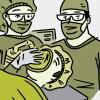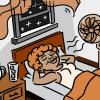Search

Biosensors and Your Health
Your body alerts you to many aspects of your health. Your stomach growling tells you when to eat. A powerful yawn lets you know you’re tired. Your body gives off many other valuable signals, but requires technology to detect them. Scientists are looking for new ways to track and use your body’s signals to improve your health and manage disease. Physical activity trackers and step counters are now…

Struggling to Sleep?
Most people who have sleep apnea don’t realize it. That’s because this disorder only occurs during sleep. Sleep apnea is when you have pauses in breathing while you’re asleep. These pauses can last from seconds to minutes. You may have difficulty breathing a few times or dozens of times an hour. These breathing pauses can be dangerous if they cause the oxygen level in your body to drop or disturb…

Waking Up to Anesthesia
When you face surgery, you might have many concerns. One common worry is about going under anesthesia. Will you lose consciousness? How will you feel afterward? Is it safe? Every day about 60,000 people nationwide have surgery under general anesthesia. It’s a combination of drugs that’s made surgery more bearable for patients and doctors alike. General anesthesia dampens pain, knocks you…

Tinnitus Cure May Lie in the Brain
Scientists were able to eliminate tinnitus—a persistent ringing in the ears—in rats by stimulating a nerve in the neck while playing a variety of tones. The finding gives hope for a future tinnitus cure in humans. Tinnitus is usually a high-pitched tone in one or both ears, but can also sound like a clicking, roaring or whooshing sound. While tinnitus isn’t fully understood, it’s known to be a…

Your Aging Eyes
You may barely notice the changes at first. Maybe you’ve found yourself reaching more often for your glasses to see up close. You might have trouble adjusting to glaring lights or reading when the light is dim. You may even have put on blue socks thinking they were black. These are some of the normal changes to your eyes and vision as you age. As more Americans head toward retirement and beyond,…

Feeling Out of Joint
Many people start to feel pain and stiffness in their joints as they get older, often when they’re 45 to 50. It’s called arthritis, and it’s one of the most common diseases nationwide. You may think it’s a disease of old age, but arthritis can affect young adults and even children. In recent years, scientists have made rapid progress in understanding the many causes of arthritis. They’ve also…

Herpes in Hiding
It’s an uncomfortable topic, but it’s a health issue you should know about. Nationwide, about 1 out of 6 people between ages 14 and 49 is infected with the herpes simplex virus type 2—the main cause of genital herpes. Surprisingly, most people don’t know they’re infected. Even if you have no symptoms, or only mild ones, you can still transmit the virus to others. Herpes simplex virus (HSV) comes…

Mystified by Menopause?
Menopause—it’s a transition that looms large in the minds of many women as they approach age 50. It’s sometimes called the “change of life.” Menopause marks the end of menstrual periods and fertility. It can be a challenging time, physically and mentally. Familiar concerns include hot flashes, trouble sleeping and mood changes, but symptoms can vary greatly for each woman. Many women don’t need…

The Prostate Prognosis
Most men probably don’t like thinking about their prostates, but it’s worth doing once in a while. Problems with the small gland are common in men past the age of 50. The good news is that most prostate conditions can be successfully treated. The prostate is about the size of a walnut. It wraps around the urethra, the tube that carries urine out of the bladder. During sexual climax, or…

Rough Up Your Diet
Fiber—you know it's good for you. But if you're like many Americans, you don't get enough. In fact, most of us get less than half the recommended amount of fiber each day. Dietary fiber is found in the plants you eat, including fruits, vegetables and whole grains. It's sometimes called bulk or roughage. You've probably heard that it can help with digestion. So it may seem odd that fiber is a…
NIH Office of Communications and Public Liaison
Health and Science Publications Branch
Building 31, Room 5B52
Bethesda, MD 20892-2094
Contact Us:
nihnewsinhealth@od.nih.gov
Phone: 301-451-8224
Share Our Materials: Reprint our articles and illustrations in your own publication. Our material is not copyrighted. Please acknowledge NIH News in Health as the source and send us a copy.
For more consumer health news and information, visit health.nih.gov.
For wellness toolkits, visit www.nih.gov/wellnesstoolkits.
